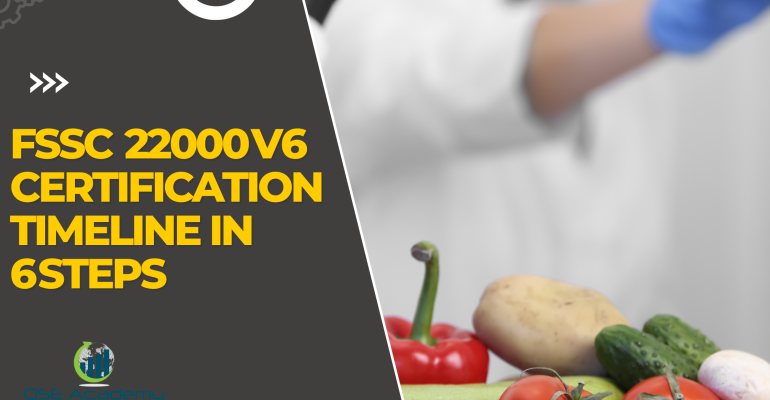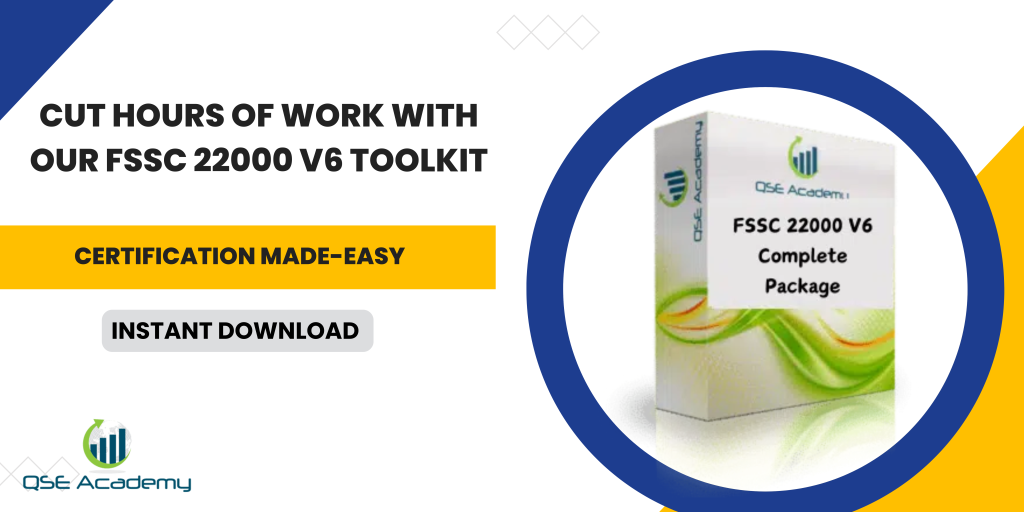FSSC 22000 V6 Certification Timeline in 6 Steps
How Long Does FSSC 22000 V6 Certification Really Take?
One of the first questions clients ask me is,
“How long does FSSC 22000 certification actually take from start to finish?”
The truth is—it depends on your current system, team readiness, and how organized you are.
But after guiding hundreds of food businesses through the process, I’ve seen a clear pattern:
those who follow a structured timeline get certified faster and with fewer surprises.
This guide breaks down the entire certification journey into six practical steps, so you can plan your budget, training, and audits with confidence.
Step 1: Conduct a Gap Analysis (Weeks 1–2)
Before doing anything else, start with a Gap Analysis.
It’s your roadmap. You’ll compare your existing food-safety practices against the requirements of FSSC 22000 V6, ISO 22000:2018, and the ISO/TS 22002 series.
Here’s what you’ll uncover:
- Missing procedures or outdated documents.
- Weak links in PRPs, traceability, or allergen control.
- Areas where your team’s understanding of HACCP needs a boost.
Pro Tip: Use a structured checklist that includes FSSC’s new Version 6 additions, like food-safety culture, food defense, and environmental monitoring.
Common Mistake: Copying another company’s documents and assuming they’ll fit your operation. It only causes rework later.
Once you know your gaps, you can build a focused action plan that defines exactly how long your certification journey will take.
 Step 2: Develop and Implement Your FSMS (Weeks 3–10)
Step 2: Develop and Implement Your FSMS (Weeks 3–10)
Now the real work begins—building or refining your Food-Safety Management System (FSMS).
Think of this phase as turning your findings into a living, functional system.
Key activities include:
- Writing or updating your food-safety policy and objectives.
- Developing PRPs (ISO/TS 22002 series) tailored to your facility.
- Reviewing and strengthening your HACCP plan.
- Setting up traceability and recall procedures.
- Introducing activities that promote food-safety culture.
Pro Tip: Don’t isolate documentation from implementation.
Train employees while you write—this keeps everyone involved and speeds up adoption.
Real-World Insight: One beverage company we supported finished this phase 30 percent faster because each department owned one clause of ISO 22000. Everyone felt accountable.
Step 3: Internal Audit and Management Review (Weeks 11–13)
By now, your system should be running. It’s time to test it.
An internal audit helps you catch weaknesses before your certification body does.
Here’s what to do:
- Plan and conduct a full internal audit covering all requirements and PRPs.
- Record findings, assign corrective actions, and verify completion.
- Hold a management-review meeting to evaluate performance and readiness.
Pro Tip: Treat the internal audit as your dress rehearsal. Ask tough questions, simulate auditor interviews, and verify evidence.
Common Pitfall: Skipping this step or doing a quick partial audit—it almost guarantees findings in Stage 1.
When done right, you’ll walk into your certification audit already confident.
Step 4: Stage 1 Audit – Documentation & Readiness Check (Week 14)
Stage 1 is where your certification body gets a first look at your system.
Auditors review documents, site layout, and your overall readiness for the main audit.
They typically check:
- FSMS documentation and records.
- HACCP studies and hazard analysis.
- Internal audit results.
- Management-review minutes.
- Legal and regulatory compliance evidence.
It usually lasts 1–2 man-days, depending on company size and complexity.
Pro Tip: When auditors suggest improvements during Stage 1, act on them immediately—you’ll save time (and headaches) before Stage 2.
Outcome: You’ll either move straight to Stage 2 or be asked to strengthen a few areas first.
Step 5: Stage 2 Audit – On-Site Certification Audit (Weeks 15–17)
This is the big one.
Your auditor spends several days on-site evaluating how well your FSMS works in practice.
Expect them to:
- Walk through your production areas.
- Interview employees.
- Review records, calibration logs, and training files.
- Verify traceability from raw material to shipment.
Duration usually ranges from 2 to 5 days, depending on employee count and risk level.
Pro Tip: Assign a process owner for each area to accompany the auditor. It saves time and prevents miscommunication.
Example: One frozen-food company completed its Stage 2 Audit in just 3 days because their process owners had clear evidence ready for each requirement.
Step 6: Certification Decision & Surveillance Cycle (Weeks 18–20 and Ongoing)
After the audit, you’ll receive a report listing conformities and any non-conformities.
You’ll need to submit corrective-action evidence within 30 days.
Once verified, the certification body performs a technical review and issues your certificate—usually 2–4 weeks later.
But certification isn’t the end.
You’re now entering a three-year cycle that includes annual surveillance audits and a full recertification at the end.
Pro Tip: Use the months after certification to refine your monitoring and internal audit process.
Strong follow-up systems make surveillance audits almost stress-free.
FAQs: FSSC 22000 V6 Certification Timeline
Q1. How long does the full certification process usually take?
For most small and medium-sized companies, about 4–6 months from gap analysis to certificate.
Q2. Can the process be shortened?
Yes. If you already follow ISO 22000 or HACCP, certification can be achieved in as little as 8–10 weeks with focused implementation.
Q3. What causes delays?
Late corrective actions, incomplete documentation, and lack of team training are the usual bottlenecks.
Plan Your Certification Journey with Confidence
Getting certified to FSSC 22000 V6 doesn’t have to drag on for months longer than necessary.
When you follow these six clear steps—gap analysis, implementation, internal audit, Stage 1, Stage 2, and certification—you move efficiently and stay in control of your timeline.
At QSE Academy, we’ve helped hundreds of organizations streamline their path to certification by combining documentation support, training, and readiness assessments.
Melissa Lavaro is a seasoned ISO consultant and an enthusiastic advocate for quality management standards. With a rich experience in conducting audits and providing consultancy services, Melissa specializes in helping organizations implement and adapt to ISO standards. Her passion for quality management is evident in her hands-on approach and deep understanding of the regulatory frameworks. Melissa’s expertise and energetic commitment make her a sought-after consultant, dedicated to elevating organizational compliance and performance through practical, insightful guidance.








